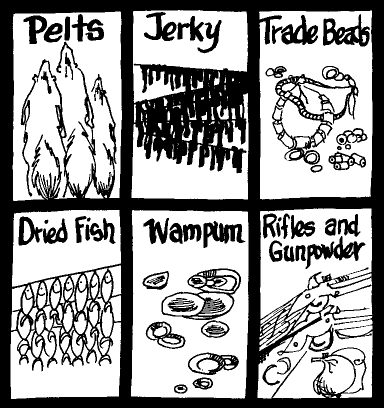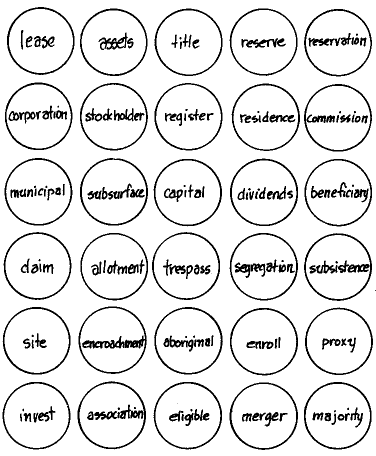
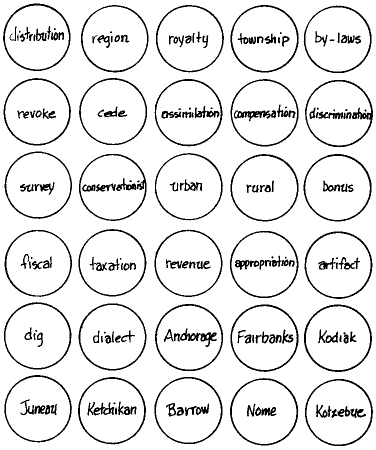

SAMPLE GAMEBOARD
|
|
WORDS AND DEFINITIONS USED IN WORD CLUE BINGO GAME
Many teachers are finding LEARNING CENTERS a helpful tool for arranging for students to become involved in their own learning.
The student assignments for this unit are set up as job cards and activity cards. The teacher may make additional activity cards, and so can the students. These activities were designed by Maxey Fritz, who also revised the student mini-text.
There are many ways to physically set up learning stations. The way this particular unit is written, with 3 sets of JOB CARDS and 1 RESOURCE CENTER, it would lend itself to establishment of each corner of the room as a separate station.
The Resource Center for this unlt should have several dictionaries, several copies of each of the Land Claims mini-texts, addresses for all the regional corporations, a large map of Alaska (with regional boundaries outlined), and perhaps an atlas.
Students should know that they are expected to do a certain number of assignments at each center. They should know in advance how many days they have so that they can budget their time. Center time can be part of a period or the whole period, at the teacher's discretion. Students should write a contract, listing for the teacher what they expect to accomplish at a particular center.
The activity cards are printed in such a way that they may be cut apart and used as they are, or they may be pasted onto 5" x 8" cards.
CONCEPTS TO BE TAUGHT:
|
WORDS TO BE LEARNED OR REVIEWED: |
|
subsistence |
DESIRED STUDENT OUTCOMES:
This is a learning packet.
It contains JOB CARDS, ACTIVITY CARDS, and a RESOURCE SECTION.
The JOB CARDS have directions for activities in LANGUAGE, in LAND CLAIMS, and in general SOCIAL STUDIES.
The ACTIVITY CARDS have assignments written on them.
The RESOURCE SECTION contains materials and information that will be helpful in completing some of the ACTIVITY CARDS. Each ACTIVITY CARD may be worked on alone or with a partner. Discuss each JOB CARD with your teacher before beginning the activities.
INSTRUCTIONS
JOB CARD ONE
Find the map of Alaska in the RESOURCE SECTION.
You will need this map for some of the activities in this section. There are 12 ACTIVITY CARDS. Choose any 9 to complete. You may do all the activities if you wish.
Read through all the cards before you start.
Learn to spell the names of the regional corporations.
When you think you can do it, have a classmate give you a spelling test.
Take the test as many times as you need to in order to make a perfect score.
Write a letter to 3 regional corporations. Their addresses are listed in the RESOURCE SECTION.
You will also need an English textbook to give you the proper form for a letter. (A typing manual or encyclopedia might also have the necessary information.)
Find out who the officers of the corporation are. Ask about projects on which they are working and investments they have made. Find out what the goals are. Ask about problems they are having.
When the answers to your letters arrive, share them with a group of classmates. Discuss what your own regional corporation is doing. Your group might have some new ideas for projects. If so, send them to the regional corporations.
Make a big wall map of Alaska. Use-the small map in the RESOURCE STATION as a guide unless you have a better idea. Put the large map on butcher paper.
Draw in the boundaries of the regional corporations and write each corporation's name in the area.
List the village corporations in each region.
Draw in the mountains, rivers, and lakes, and label them.
Put symbols on the map to represent natural resources in each region. Make a legend to show what the symbols mean.
Be sure to put your own village on the map.
Write to your own regional corporation headquarters.
Find out some of the things the corporation is doing that will affect your future.
Find out all the jobs in the regional corporation, how much training is needed for each job, and what the salaries are.
Decide what jobs you might like to do. Tell the class about either the projects or the jobs.
Make a model, drawing, or write a story about one of the projects or jobs.
Write a story about your village. Try to explain to somebody in Texas or California what it is like to live where you do.
Include everyday activities, things you do for fun, seasonal work, and the like.
Pick a town in Texas or California or Minnesota or Connecticut. Send your story to:
|
A GOOD SOCIAL STUDIES TEACHER |
Write a note asking that the letter be forwarded, if possible. Ask the teacher to see if a student in his or her class will write back to you, telling how his or her life is like yours and how it is different.
Share your letter with the rest of the class when you get a reply.
Interview two people in your village who helped choose village lands at selection time.
Write a report on your finding to share with the class.
Invent a simulation game on "How to Select Lands." Let students in the class take the roles of people in the village. See if the class comes up with the same selections as those really made!
Find the oldest person in your village.
Talk to him or her about changes that have occurred in the village in a lifetime.
Make a wall chart showing important events and dates in the lives of the old person.
Make a FUTURE CHART. On it, try to predict what changes will occur in your lifetime.
How are decisions made in the village?
Is there one group that makes decisions about important village affairs?
Is this the same group that makes decisions at school?
Try to identify as many groups as you can who make decisions concerning village life. Are the decisions they make public or private decisions? Are the decisions in the interest of all or only a few?
Do you think decisions are made the same way in other places?
Keep a list for a week of all the decisions made that affect your life. Have two columns, DECISION MADE and WHO MADE THE DECISION. Write a paper summarizing your findings.
Draw a map of your village.
Include your house and the homes of your friends.
Draw in the streets and other important places.
Using your map, plan a treasure hunt for the rest of the class. Put clues on the map and see if the class can read them.
Plan with the teacher when to conduct the treasure hunt.
Look up the word subsistence in the dictionary.
Make a list of all the subsistence activities done in your village.
Imagine what would happen if all the subsistence activities stopped. Write a story about what you think might happen.
Write a history of your Native group. Use legends and older people in the village to help you.
With several other people, write a drama depicting the history of the village. Present the drama to the class or to a class in the elementary school.
Have everyone in your class write down one good reason why he or she is proud to be an Alaska Native. Make a big wall display with the name of your regional corporation, your village, and your Native language.
Write down the names of all your classmates, and their reasons for Native pride. Write down also what each person is good at as an individual.
Example:
|
|
|
|
|
|
|
|
|
|
|
|
INSTRUCTIONS
JOB CARD TWO
Look through the activity cards in this section.
Choose 6 that you would like to do.
Contract with the teacher before starting.
You will both need to decide whether each card needs to be checked by the teacher or shared with the class.
Find one of the longest words in the reading section. Write it down.
Look up its definition in the dictionary.
Your word may have more than one meaning. If so, write them all down and draw a line under the definition for the word as it is used in the Land Claims Book.
Tell someone else what the word means.
Select a word from the reading assignment, a big word. It may be the same one that you used in Activity 1, or a different one.
Divide your word into syllables. Underline the consonants and circle the vowels.
Find another word in the dictionary with the same number of syllables or the same number of vowels and consonants.
Back to the dictionary!
Find a word that has the opposite meaning to your word. Write down its definition.
Put both words on a card. Label the card "OPPOSITES."
Use each word in a sentence on the card so that others can learn the words.
Put the card on the bulletin board. Look at the other word cards there.
Select another word from the reading.
Find a word in the dictionary that has a similar meaning.
Make a sentence with each word and write the sentences on a card.
Label the card "SYNONYMS".
Post the card on the bulletin board. Look at the word cards that others have posted there.
Choose another new word from the reading.
Write it down.
In the dictionary, find a word you like that has the same number of letters as the word you just selected.
Find out what it means. Use it in a sentence. Learn to spell it.
Is there a word in your Native language that has the same meaning?
Write a story about one of the new words you have learned.
It might be a history of the word.
It might be a story about a hero or a heroine who has your word for a name.
It might be about someone who could never learn how to spell it.
When you are finished with your story, give it to three people to see how they react to it.
Look at the list of new words you have learned.
Select one and find a word that rhymes with it.
Learn what the new word means.
Make up a nonsense poem using the two words that rhyme.
Make a crossword puzzle or a brainbuster using words from any of the Land Claims Books.
Put it on a dittomaster so it can be duplicated.
Make copies for everyone in class. See how many can work the puzzle.
(See teaching manual, page 238)
Look back over all the Language Activities you have done.
Select one and do it in your Native language.
Share it with someone else in class.
INSTRUCTIONS
JOB CARD THREE
You are to complete 6 of the following activity cards.
You will need to refer to Land Claims Books 5 through 8 to help you.
Draw a picture that illustrates subsistence living.
Draw a picture that illustrates non-subsistence living.
Put the pictures on opposite ends of a line.
/ / / / / / / / / / / / / / / / / /
|
This is subsistence living. |
This is non-subsistence living. |
On the scale, put a G where your grandparents would have been in relation to a completely subsistent life. Put an X to show where your family is today.
Draw a land-use map of your village and surrounding areas.
Draw symbols to represent areas where food is gathered or hunting is done.
Draw two pictures showing the difference between surface resources and subsurface resources.
What subsurface resources are found in your region?
Find out who owns these subsurface resources and how much money they make from them.
Research (by reading or interviewing people) what the Native Land Claims Settlement will actually mean to you in terms of:
Write a paragraph, summarizing this information.
Write an imaginary letter to a student in New York City telling her or him what you consider to be the four major events leading to the Native Claims Settlement.
Does the Settlement Act have anything to do with a young man or young woman living in New York City?
The year is 1992.
The taxes on your land amount to several hundred dollars.
Imagine what you will be doing at that time, and what your life will be like.
Write a paragraph telling how you plan to obtain the money to pay the taxes on your land.
Imagine that your grandparents have asked you to come to see them and to explain what the Native Claims Settlement is all about.
With two other people, practice role playing the situation. Take turns playing the grandparents and take turns explaining.
Imagine that you are 21 and that you have decided to leave Alaska.
Talk to the village elders, or read, to find out if this move will change the benefits you are entitled to under the Native Claims Settlement Act.
Imagine that you have just graduated from high school.
You are trying to decide what to do with your life.
Talk to 4 older people in the village and ask them for advice. Write a paragraph to summarize what they said.
DESIRED STUDENT OUTCOME:
Students will become familiar with a selected body of facts.
STRATEGIES:
Prepare a set of clues (or have a group of students do this during their research).
Keep clues together for each separate act or treaty.
The teacher or student leader selects one pack of clues and reads them one at a time to the class. Students at any time may guess the answer by standing to be recognized.
If they are wrong, they are out of the game.
If they are correct, they become the leader (reader of clues) for the next round.
The teacher should be alert for points to be clarified or any other teachable moments or take-offs for discussion.
Use reward freely.
DESIRED STUDENT OUTCOME:
Students will build a vocabulary to discuss the Alaska Native claims settlement.
MATERIALS NEEDED:
STRATEGIES:
One student can call out the word he or she pulls at random from a box of tokens.
Students who recognize on their Word Clue Cards the definition that fits the word may cover it with a blank token.
Whoever gets a whole row of definitions covered may call out "ALASKA!" She or he reads to the caller the definitions and words in the covered row.
The game can proceed indefinitely.
VARIATIONS:
Until students gain some familiarity with the words and definitions, both may be read by the caller. A reference list is included.
A quiet form of the game could be played by 2-4 students who leave the word tokens face down and take turns drawing, covering definitions on their cards as they draw the matching words.



SAMPLE GAMEBOARD
|
|
WORDS AND DEFINITIONS USED IN WORD CLUE BINGO GAME
|
region |
- a division or part. |
|
royalty |
- share of the proceeds paid to the owner, developer, creator. |
|
township |
- unit of land 6 miles square. |
|
by-laws |
- laws or rules adopted by an organization for its meetings or affairs. |
|
revoke |
- withdraw, repeal, cancel. |
|
cede |
- to transfer a title |
|
assimilation |
- absorption, incorporation. |
|
compensation |
- payment |
|
citizenship |
- legal right to civil participation. |
|
discrimination |
- showing of partiality or prejudice. |
|
survey |
- to determine the location, form, boundaries of land; a written description of an area. |
|
conservationist |
- one who is responsible for the care and protection on natural resources. |
|
urban |
- in or making up a city. |
|
rural |
- of, like, or living in the country. |
|
bonus |
- anything given in addition to the customary or required amount. |
|
allotment |
- apportionment, share. |
|
trespass |
- to enter another's property without permission or right. |
|
segregation |
- the policy of compelling racial groups to live apart. |
|
subsistence |
- means of support or livelihood. |
|
site |
- location. |
|
encroachment |
- act of trespassing; intrusion. |
|
aboriginal |
- existing from the beginning. |
|
enroll |
- to become a member. |
|
proxy |
- the authority to act for another; a person so authorized. |
|
invest |
- to put money into business in order to get a profit. |
|
association |
- an organization or society. |
|
eligible |
- qualified. |
|
merger |
- combining of several companies into one. |
|
majority |
- the greater number. |
|
distribution |
- the giving out in the form of shares. |
|
fiscal |
- relating to public funds. |
|
fiscal year |
- July 1 to June 30. |
|
taxation |
- compulsory payment of a percentage of income, property, etc. for the support of government. |
|
appropriation |
- a setting aside of money for a specific use. |
|
artifact |
- any object made by human work. |
|
dig |
- an archaeological excavation. |
|
dialect |
- the form of a spoken language peculiar to a region, social group, etc. |
|
Anchorage |
- largest Alaska city. |
|
Fairbanks |
- northern-most point of the Alaska Railroad. |
|
Kodiak |
- island south of Cook Inlet. |
|
Juneau |
- capital of Alaska. |
|
Ketchikan |
- center of Alaska's salmon industry. |
|
Barrow |
- located on the extreme northern tip of Alaska. |
|
Nome |
- chief distributing center of northwestern Alaska. |
|
Kotzebue |
- an Eskimo town 50 miles north of the Arctic Circle. |
|
Yukon |
- river that runs through Dawson City and Circle. |
|
Kuskokwim |
- river that empties into the sea near Bethel. |
|
lease |
- rent land under contract. |
|
assets |
- all property, accounts receivable, cash, etc. of a business or person. |
|
title |
- a right to ownership. |
|
reserve |
- something kept back or stored for later use. |
|
reservation |
- public land set aside for special use. |
|
corporation |
- a group of people organized under charter with some of the same legal rights as an individual. |
|
stockholder |
- one owning stock in a given company. |
|
register |
- to enter one's name on a list. |
|
residence |
- place where one lives. |
|
commission |
- a group of people chosen to do something. |
|
municipal |
- concerning a city, town or its local government. |
|
subsurface |
- beneath the surface. |
|
capital |
- seat of government; wealth; money, property used in business. |
|
dividends |
- sum to be divided among stockholders; bonus. |
|
beneficiary |
- person named to receive an inheritance. |
|
claim |
- a right to something. |
|
Koniag, Inc. |
- region that includes Kodiak. |
|
Sealaska |
- region that includes Juneau. |
|
Aleut Corp. |
- region that includes Unalaska. |
|
Cook Inlet Region, Inc. |
- region that includes Anchorage. |
|
Doyon, Ltd. |
- region that includes Fairbanks. |
|
Arctic Slope Regional Corp. |
- region that includes Barrow. |
|
Bering Straits Native Corp. |
- region that includes Nome. |
|
Ahtna, Inc. |
- region that includes Copper Center. |
|
Calista Corp. |
- region that includes Bethel. |
|
N.A.N.A. Regional Corp. |
- region that includes Kotzebue. |
|
Bristol Bay Native Corp. |
- region that includes Dillingham. |
|
Chugach Natives, Inc. |
- region that includes Valdez. |
DESIRED STUDENT OUTCOME:
Students will become familiar with Alaska Native regions.
STRATEGIES:
Player spins the spinner and stands on the map, touching the region indicated.
At his next turn, the player maintains touch with the original region, plus the new one.
All players keep their positions on the game board.
The winner is the last to fall while attempting to keep in touch with all the regions indicated by the spinner when it came his turn.
Large maps of Alaska can be obtained from the U.S. Geologic Survey office in Anchorage, 508 west 2nd Avenue, phone (907) 277-0577.
These large maps can be covered with contact paper to protect them
from the wear and tear of being walked on. 
VARIATIONS:
Spinning the dial could be the clue for giving certain facts about the region that are worthy of memory. For instance, name an industry of the region, or a river, or a natural resource, or a city or village.
Students might be asked to give one fact about a region each time he spun the dial.
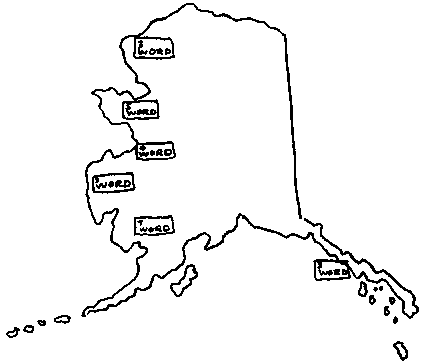
DESIRED STUDENT OUTCOME:
Students will develop a vocabulary concerning Alaska and the land claims issue.
TIME: 30 minutes, more or less.
GROUP SIZE: 2 to 6 players.
MATERIALS: Game board, with vocabulary cards labeled with value points, paper and pencil for keeping score, an object to toss (paper clip or penny).
STRATEGIES:
Place a line on the floor (masking tape or chalk mark) eight to ten feet from the map.
Players toss a paper clip onto the game board.
When the clip lands on a card, the player may get the point value on that word if he or she can make up a sentence that demonstrates the meaning of the word.
Other members may question the player.
If the player does not know the meaning of the word, he or she may ask one other person to help. If another person helps the player, they divide the points equally (round to highest number).
If a paper clip lands touching two cards, the player may use each of the words in a sentence and receive the total value of the two words.
Each player moves his marker around the map according to the number of points he receives from his turn.
Acceptance of the correct usage of the word is based on the consensus of the group. If there is disagreement, someone may look it up.
Word cards may be changed with each new book.
VARIATION: The same game may be used to work on pronunciation or spelling.
DESIRED STUDENT OUTCOME:
Students will become familiar with vocabulary pertinent to understanding the Alaska land claims issues.
STRATEGIES:
Use a large map of Alaska with it sectioned off into 60-90 coastline squares.
Students roll dice and draw a vocabulary card.
If they can do what the vocabulary card asks them to do, they may move as many spaces as the points on the dice they rolled.
If not, they remain where they are.
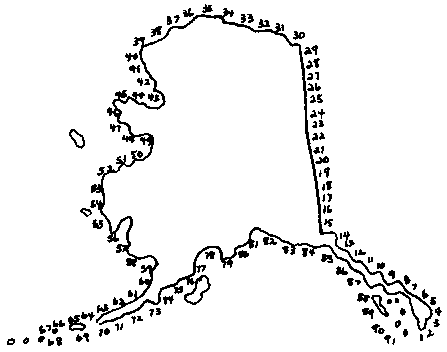
Use the word stockholder in a sentence to show that you know its meaning.
Hand this card to another player and spell corporation.
Use the word compensation in a sentence to show that you know its meaning.
Hand this card to another player and spell allotment.
Define subsistence.
Define township.
|
|
|
|
|
|
|
|
|
|
|
|
|
|
|
|
|
|
|
|
|
|
|
|
|
|
|
|
|
|
|
|
|
|
|
|
|
|
|
|
|
|
|
|
|
|
|
|
|
|
|
|
|
|
|
|
|
|
|
|
|
|
|
|
|
|
|
|
|
|
|
|
|
|
|
|
|
|
|
|
|
|
|
|
|
|
|
|
|
|
|
|
|
|
|
|
|
|
|
|
|
|
|
|
|
|
|
|
|
|
|
|
|
|
|
|
|
|
|
|
|
|
|
|
|
|
|
|
|
|
|
|
|
|
|
|
|
|
|
|
|
|
|
|
DESIRED STUDENT OUTCOME:
Students will learn the components of some of the pressures that led to the settlement of the Native Land Claims.
GROUP SIZE: Two to four players per deck.
TIME REQUIRED: Twenty minutes or as long as interest holds.
MATERIALS:
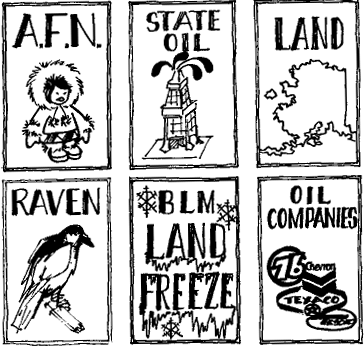
STRATEGIES:
The cards are dealt five to each player, and the deck is placed in the middle, with one card turned face up beside the deck. Each player in turn may select the face-up card or draw a card from the top of the deck and then discard one.
The objective is to acquire one of each of the different cards. When this happens, the player announces, "LAND SETTLEMENT!" and lays the cards down and repeats the significance of each card in this sequence:
The cards are then placed as a stack player and play continues as the players accumulate more stacks or "tricks."
To decide who deals and plays first, each draws for high card. Each player wants to acquire as many LAND SETTLEMENT stacks as possible. When all the cards run out, each player counts the number of stacks. The one with the most is the winner.
VARIATIONS:
For more players or a longer game, two decks could be put together. Let students develop additional rules or develop their own card game. Quotations could be put on the cards and each player could read the quote aloud to the group each time he acquired enough cards for a LAND SETTLEMENT.
DESIRED STUDENT OUTCOME:
Students will experience the feelings of the "haves" and the "have-nots" and will have an opportunity to plan together for the general good.
STRATEGIES:
Free the classroom of all furniture, except for four tables, located in various parts of the room. (These tables cannot be moved during the game.) Total number of cards should correspond to the number of people participating in the game. Have students' names listed on the board.
Inform the players of the game that each different card equals one of Alaska's resources. Yellow equals fish and animals; black, oil; red, minerals such as gold, copper; green, lumber.
HOW THE GAME IS PLAYED:
Set an alarm clock or stop watch for 30 seconds.
Round One. In the first 30 seconds, each of the participants must gather colored cards to purchase food. One of each kind equals food. A person may go one round without food. At the end of the second round anyone who doesn't have one each of the resource cards is out of the game. It is okay for players to use any strategy they think will allow them to survive. They might try to get as many cards as possible to use for later manipulation and bargaining, trading or hoarding. (Any torn card no longer counts and is considered pollution). They may form cooperative teams during the time allotment. They might wish to organize the gathering process. It's up to each player to collect at least one of each of the survival cards during the thirty seconds. Ready...... START!
At the sound of the alarm, those having acquired at least one each of the four natural resource cards write "FOOD" under their name.
Collect the cards from the students and distribute them back to the table tops.
Round Two. Set the alarm for 15 seconds. On this round those that do not have food are collecting cards for food. Those that do have food by their name are collecting one each of the four resource cards to get clothing. Remember that any one without food at the end of this round is out of the game. Once again open discussion is encouraged. Trading and attempts to organize the process are allowable.
At the sound of the alarm those having acquired at least one each of the commodity cards get either food or clothing, after their name. Those failing to secure at least one set of four cards are out of the game.
Collect cards and distribute them back on the table. Hold out a set of cards for each person out of the game.
Round Three (Planning stage. Time limit is 10 minutes). Those out of the game cannot talk. During this time the survivors may organize in any way they wish. This round will get the students houses and cars. There is a national shortage on some of our resources. There will be 10% fewer cards than participants.
Set the alarm for 10 seconds. Players must collect one each of the natural resource cards to get homes and cars after their names. Put the cards back but again decrease them by 10%. Remember any card torn is counted as wasted natural resources and will not count.
Round Four(Planning stage. Time limit is 10 minutes). There is still a depletion of our natural resources so there will not be enough cards for everyone. This round will be worth a vacation around the world and a chance to make your own selection of what you might like to do (ski, sail, go to plays) as an activity.
Set the alarm for 5 seconds. Again, players that have one each of all four of the cards write "Vacation" and their own selected hobby or activity under their name. Collect all the cards and put them away.
DISCUSSION:
Have the whole class sit in a circle and ask them to talk about all the ways this game could be like the real use of natural resources in the State of Alaska and the world.
What do you feel about being eliminated from the game? How did others feel about the people that couldn't play? How did you feel when you did or didn't get houses, cars, vacations, etc.?
What kinds of things did students do to be especially successful? How are these actions like real life?
What didn't you like about the game? How would you like it to be different? Invent new ways of playing this game to make it parallel real-life situations.
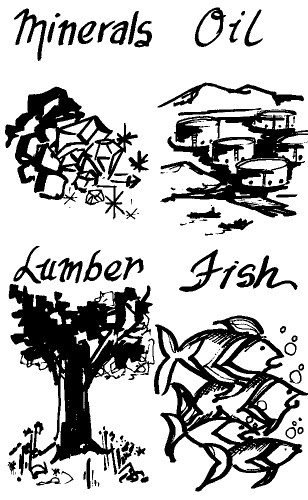
DESIRED STUDENT OUTCOME:
Students will participate in an activity where power to govern falls into the hands of one class of people and will analyze the effect of such a process.
The game kit should include:
|
pelts |
rifles & gun powder |
Vocabulary
- jerky
pelts
maize
wampum - how it differs from trade beads
tea (blocks)
STRATEGIES:
This is a game in which students experience some of the concepts in Book 2, North American Indians. Round I simulates a barter system of goods within two groups, an Indian tribe and the colonists. Before the trading session begins students in each group determine the economic value system for the goods that are common to their group. By the end of the first round a chief and a captain will be selected for each group based on those students who have succeeded in acquiring the greatest number of goods or trading points. Round II simulates a meeting between the captain of the colonists and the chief of the Indian tribe. Before beginning Round II the teacher holds up two blank wild cards of different colors. The students are told that the wild cards represent things which could benefit both groups. Each group then assigns a value to their unknown wild card. The colonists are secretly instructed to trade anything for the chief's wild card which represents all of the tribal lands. The colonist's wild card represents health, education and welfare benefits to the Indians. If the colonists do not succeed in trading for the Indians wild card in Round I, repeat the round, and instruct the students that they have no choice the wild cards must be exchanged.
Round III gives the colonists the power to make the rules of the game since they now control the land. Almost invariably they will make rules that enhance or secure their position of power. The Indians, of course, will consider these rules unfair, and resist them overtly or covertly. The group will experience on the one hand an exercise of total power, and on the other, the helplessness of those who feel the system working unfairly against them.
As with all simulations, the discussion session following the game is as important as the game experience itself. The game requires a minimum of 4 players and a maximum of 30. The game and debriefing may take approximately 2 1/2 hours.
Advance Preparation
Before the students arrive, form the chairs in the classroom into two circles. Each circle should contain an equal number of chairs. When the students arrive, they may sit in either of the two circles.
Preparing the Students for the Game
Introduce the simulation by telling the class that they are going to be transported back in time to a remote wilderness area where they will be an Indian tribe which has lived in the area "since time immemorial" and a group of colonists who have recently settled in the area. Explain that individuals in each group will be given 5 trading cards each having a picture of something that was valued by the colonists. Give each group the wall chart of trading cards for their group and their deck of cards.
|
INDIANS pelts |
COLONISTS rifles & gunpowder |
If any of the above terms are unclear to the students, explain the term.
Explain to the two groups that each group will have 10 minutes to make a decision on the number of value points awarded for each trading card. It is important that the other group does not know what points your group has set for each of your cards; only members in your group should know the point system. Write the number of points by each trading card on the wall chart, but do not let the other group see it. Shuffle the deck of cards for each group. Each deck should contain 15 of each trading card. Each student in the group is dealt 5 cards by the instructor or facilitator.
ROUND I - The Trading Session
Tell the students that they will have 10 minutes to try to improve their hand. They improve their hand by trading advantageously with other players in their group.
Trade Rules
Start Round I by saying, "Trading begins now". At the end of 9 minutes give them a one-minute warning; "The trading session is over in one minute". Have students in each group compute their points. Whoever has the highest number of points is designated chief for the Indians and captain for the colonists.
ROUND II - The Treaty Session
ROUND III - The Reservation
If the wild cards are exchanged in Round II, tell the Indians that their wild card represented all of their tribal land and the wild card they received in return represented health, education and welfare benefits from the colonists. Announce that since the colonists now control the land they now make up all of the rules for the rest of the game which the Indians must obey.
Giving the Power to Make the Rules
After the second bonus session, and resulting promotions, announce that, because the squares have worked so hard, they now have the authority to make the rules for the game. The Indians may suggest rule changes, via written message to the colonists, but the colonists may accept, reject, ignore or modify any such suggestions. If sessions move slowly, to give the colonists an understanding of the depth of their power you might indicate to them, privately, that they can make rules such as: Require all Indians to bargain with the colonists even though they have their arms folded, require the Indians to give the colonists the trade cards they ask for regardless of whether or not the Indians want to trade, redistribute the trade cards on a more equal basis, etc. Probably such suggestions will not have to come from the facilitator.
Have the colonists announce any rules that they establish to all of the participants unless they want the rules kept secret.
Tell the Indians that they can propose rules if they are written on paper. If the Indians fail to comprehend the situation when the colonists make rules, point out to them that they have three options: They can obey them, they can try to persuade the colonists to change their minds if they don't think the rules are fair, or they can revolt in some way, perhaps by walking out, refusing to play, refusing to trade with the colonists, or the drastic measure of erasing the scores. It probably will not be necessary for these suggestions to come from the facilitator. The number of protest alternatives you mention depends on how much you feel you can take on that particular day. If given, these instructions should be given to the Indians after the colonists have started discussing what rules they are going to make so that they will not hear it. If the Indians decide to revolt, it is up to the colonists to enforce the rules, not you, the teacher. This may lead to a situation in which you have to end the game, but the game shouldn't be ended before the colonists see that they are going to have a problem enforcing "unfair" rules.
Discussing the Implications
The emphasis in the game is on winning and grants to the winners absolute power to use as they will. Versions of this game have been played with a wide variety of different groups of all ages with essentially the same result: When given absolute power in a highly competitive system, the tendency is for people to use that power in ways which enhance their own power regardless of the consequences to the other groups. Sometimes when the Indians get angry at the colonists for making such harsh rules, ask, "What would have happened if the Indians had been put in the position of the colonists? Would they have acted differently?"
The system is defined by a set of rules. Rules are the foundation of governments in civilized society. Political scientists are concerned with the various types of rules that people use to govern themselves and the effect of those rules on the people. The game represents one type of government, a government in which a small group of people are given the power to make the rules. It approximates the kind of government that certain of the Indians felt they were living under due to unfair treaties. The "revolution" that generally occurs in the game is, in one sense, similar to the revolt by various Indian tribes and confederacies. One approach for the post-game discussion is to capitalize on this similarity by asking the students to analyze Indian wars as political scientists as well as historians. The most significant principle that can be learned from the discussion is that rules that govern a people and the process that created the rule affect how people react to those rules, as well as to one another.
To help the students analyze the simulation in these terms, organize them into groups of four or five made up of a cross section of colonists and Indians. Ask them to suppose that they are a group of scientists interested in studying the rules that people use to govern themselves and the effect that such rules have on people. What are some of the hypotheses that such a group might derive
from this game? To help them develop these hypotheses, they should try to answer the following questions:
